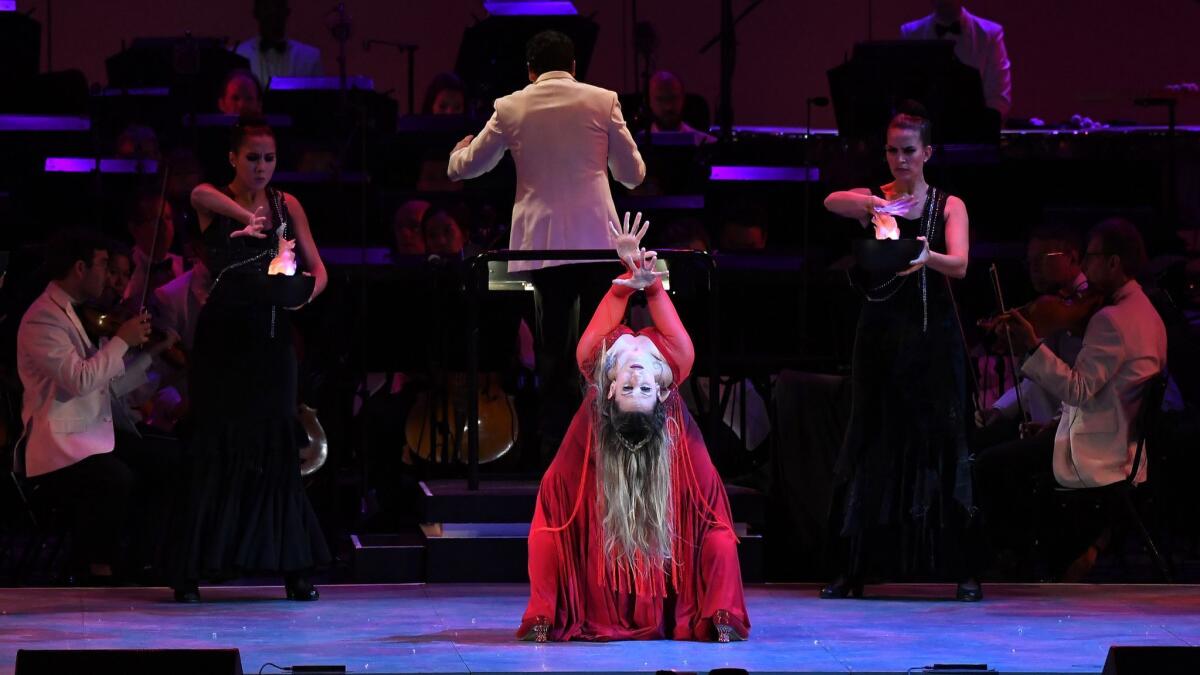Review: L.A. Philâs newly promoted Bortolameolli casts a flamenco spell at the Bowl

If there is a single takeaway from the Los Angeles Philharmonicâs centennial season, technically completed last month but now bleeding into summer, it is that a symphony orchestra can be and do pretty much any meaningful thing it damn well pleases. Just like gender, genre is so 20th century.
That means intimate installation art for an audience of one or an experimental crowd-sourced piece for everyone in the audience to sing. It means opera and theater and education and parades and community outreach. It means new music by masters and by teens. It means opera and theater, salad making and throwing watermelons off a balcony, political and social engagement.
Right now, dance is the ticket, and genre-breaking dance in its own right. Thursday night at the Hollywood Bowl, the L.A. Phil revived the Siudy Flamenco Dance Theaterâs version of âEl Amor Brujo,â the main offering of a program called âFalla & Flamencoâ conducted by the orchestraâs newly named associate conductor Paolo Bortolameolli. This weekend comes the L.A. Philâs collaboration with the Royal Ballet and Company Wayne McGregor in three works by Thomas Adès that had been commissioned by the L.A. Phil over the past decade, including the choreographed premiere of âInferno,â one of the centennial hits.
Tuesday night, when Gustavo Dudamel returns for a two-week stint at the Bowl, another centennial sensation, Benjamin Millepiedâs brilliant gender-fluid, video-enhanced on-site choreography of excerpts from Prokofievâs âRomeo and Juliet,â will be expanded and adapted to the amphitheater.
As it turns out, âEl Amor Brujoâ (âLove Bewitchedâ) has its own L.A. Phil and Hollywood Bowl legacy. The final version of Manuel de Fallaâs ballet score entered the orchestraâs repertory in 1930, seven years after its premiere in Paris and only 11 years after the orchestraâs founding. In 1946, the Bowl celebrated its Silver Jubilee with Leopold Stokowski conducting the ballet score with the Hollywood Bowl Symphony Orchestra. âIt was a cool night in Hollywood Bowl,â Isabel Morse Jones wrote in these pages, âuntil Stokowskiâs âEl Amor Brujoâ fired the blood.â The conductor then performed 10 (!) encores, and two days later brought the orchestra back on the stage to make the first recording of the full score. It may still be the most colorful and alluring.
The recording, however, also served to remove the ballet all the more from its Andalusian Roma roots. The Spanish composerâs earlier 1915 chamber orchestra version had been commissioned by a flamenco dancer and included spoken dialogue as well as songs for a cantaora voice, or gypsy singer. But the score became popular only after the Spanish composer turned it into a luminously orchestrated conventional ballet to suit the French tastes.
Still, flamenco has never given up trying to reclaim the ballet. Siudy Garridoâs version was both a little uncomfortable and revelatory when Dudamel presented it at Walt Disney Concert Hall four years ago. The Venezuelan flamenco dancer, choreographer and costume designer creates a strange hybrid, adding an introduction and interlude with music by guitarist JosĂŠ Luis de la Paz and percussionist Diego Alvarez that introduce the lovers â Garridoâs Candelas and Manuel Gutierrezâs Carmelo â in flamboyant fast-footwork flamenco style.
Candelas is spooked by the spirit of her dead husband and must break the spell to accept Carmelo. The extensive new parts are Garridoâs hair-raising dance over the coffin at her husbandâs funeral and, later, Gutierrezâs spectacular grandstanding solo. A stridently effective flamenco singer, Argentina LĂłpez, serves as Candelasâ Soul. The Ghost, elegantly danced by George Akram, retains the roving eye he had in life and is distracted by Lucia (Anali Alcantara) so the lovers can have their seductively erotic interlude.
All of this worked better in the Bowl with its large stage, superb amplification and special atmosphere than it had in Disney, where musical, acoustical, theatrical and dance styles were more in conflict. Gorgeous lighting helped. There was room for the expert corps de ballet, although much of their work was lost on the large video screens.
On the other hand, close-ups of the dancers on video created heavy-handed silent-film era melodrama. Plus, the benefits of fine amplification meant a greater clashing of musical realms, orchestral and flamenco, reminding us that Fallaâs intention was not to simulate flamenco but make something new.
For that, Bortolameolli came to the rescue in an enthusiastic, multihued performance, vibrant as Stokowski. Yes, the âRitual Fire Danceâ once more fired the blood, but it was a night best suited to the L.A. Philâs lyrical sweetness, which added a glow to the night.
Bortolameolli opened the program with excerpts from Fallaâs most famous ballet, âThe Three-Cornered Hat,â played with delight in mind, as was the curtain-raiser â Ravelâs âAlborada del Gracioso.â
Having proved himself indispensable last season as the orchestraâs then-assistant conductor leading music new and old â and as the conductor for the triumphant Meredith Monk âAtlasâ production â Bortolameolliâs promotion is yet another bequest of an L.A. Phil centennial that shows no intention of ending any time soon.
More to Read
The biggest entertainment stories
Get our big stories about Hollywood, film, television, music, arts, culture and more right in your inbox as soon as they publish.
You may occasionally receive promotional content from the Los Angeles Times.











